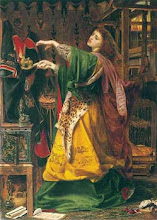 The myth is a narrative that says like the things they happened for the first time in the world. For Lévi-Strauss (1989), whenever the man thinks, he produces myth. This also is the opinion of Bachelard (1994), for whom the science must be psycanalized, divested of the thought first, since this one is always replete of the myths of the scientist, of his culture, of his time.
The myth is a narrative that says like the things they happened for the first time in the world. For Lévi-Strauss (1989), whenever the man thinks, he produces myth. This also is the opinion of Bachelard (1994), for whom the science must be psycanalized, divested of the thought first, since this one is always replete of the myths of the scientist, of his culture, of his time.The sacred one is thought how an anthropological reality, in so far as all the societies seem to have developed this type of notion. What we understand for anthropological, is what we glimpse how such, from what it is defined by the anthropological theories as being " specifically human If we were understanding the human phenomenon how natural, in the same way that supposedly there was a predisposition for the affectionate life, we would have it also for the religious experience, in so far as the religions would send us for the reconnection with this primordial feeling. In this perspective, the sacred one would be a category beforehand, because innate, originating from the human spirit.
Against the theory of the aprioristic inatism of Kant as for the categories of the understanding, the Sociological French School, with Durkheim (1989), presents the sociological hypothesis. In this perspective the feeling of the sacred one would originate in the social life itself. What the religious man would adore through his religion would be the society itself, his values, his world vision. So, we would have the tendency to send for the field of the sacred one, everything that we find important for the social reproduction.
In this way, for Durkheim, the feeling and the attitudes for with the sacred one would not be applied only to the religious objects, but also to any other sphere of the social life, just like the civic, familiar, loving or political sphere.
While approaching the sacred of the point of phenomenologycal view Rudolf Otto (1985), defines it how being the feeling of " terrible and fascinating mystery ". Without being able to locate the origin of this feeling, it defines it that I eat beforehand, but, not innate. It distinguishes three cognitive kinds of apprehension of the sacred one: the appraisers (followers); the prophets (producers of religion) and the personificadores, which bring near the condition of children of the divinity.
The tremendum is the tremendous one, the Almighty, the energy; the misterium is the qualitatively different one (when the totally different one was survived how), and the fascinans. The word sacred already would be a nun because it suggests the indescribable thing and the perfection - you do not conceptualize terms - surpassing the rational connotations and ethics, presenting - if like something objective and extern to me. Without being able to be defined done not even not even taught; it must be evoked or woken in the feeling and described by analogy or metaphor
The characteristics of the sacred one are summarized in the word numinous. The object for which the numinous addresses is the mysterium tremendum, the existence of terror before the power of the different one and of the fascinating one, the feeling of creature before the creator.
The numinous (the sacred one), is, before all, an interpretation and evaluation of what exists in the exclusively religious power. Treat complex category, since it passes by several powers, just like the ethics and the aesthetics, but it guards an irrational differential because not accessible to the understanding conceptual, in this sense the sacred one is indescribable. In agreement with Otto, the religion is not sold out in expressed you ration out or in the act of showing the relation of his elements up to decipher it.
The lively element in all the religions is the idea of quite absolute one, which is the sacred one and the saint as final result of the schematization and of the ethics saturation of an original and specific feeling, which Otto calls of numinous saying: I talk about a numinous category like a special category of interpretation and of evaluation, a state of soul that is shown when this category is applied, i.e. every time an object is conceived how numinous.
It is not possible to understand what it is this state of soul, without being attracting attention of the listener for the possibility of this feeling, when the point it think in his intimate life where he appears and becomes conscious.
For Rudolf Otto (1985), the sacred one is a category been composed of rational elements and you do not ration out, in both cases, it is a category beforehand. The rational ideas do not come from any sensitive perception, exist in the pure reason, there are an original predisposition of the spirit. You do not ration the elements out that it is anything more deep than the pure reason (there are the depths of the soul).
Support in Kant, for whom all our knowledge begins with the experience, but it does not proceed only from it. In the empirical knowledge he distinguishes the knowledge received through our impressions and what our faculty of knowledge produces, asked by sensitive impressions. The numinous appears of the fountain of knowledge more deep than it exists in the soul and that it appears thanks to the sensitive experiences, which are the exciting objects
For Otto, on trial of which the fountain of the numinous is the knowledge it is beforehand that we find in him the latent state, the convictions and the feelings that allow inferences. These convictions are not sensitive perceptions, but interpretations and strange evaluations to the data supplied by the perception.
The pure concepts of the understanding and the ideas and moral and esthetic evaluations show that it exists it hides in the soul a fountain of representations and of feelings independent of all sensitive experience. In the spiritual world, the fact first is a thinking spirit. The man is the presupposition to understand the creation and the humanity in you
The spirit that is developed in the world supposes the absolute spirit like basis of his possibility (power and act). This fountain is a latent arrangement of the human spirit. To be updated need spirits arranged the religion, this arrangement becomes an impulse and search. The predisposition that the human reason loads in you becomes an internal impulse, religious feeling, and through his productions the man takes conscience of you himself. The demonstration of the sacred one would be the real reaffirmation of eternal truth.
What would be the difference between myth and religion? Of the angle of the creation of onthologics reality, there is no difference, visa what the myth and the feeling of the healthy sacred one fountains of knowledge able to provoke the demonstration of the being. Meantime the religion is the institucionalização of the feeling of consecrated, what it teases in routines and dogmas commemorated in ritual aiming to remember and to fix the mythical primordial event.
For Mircea Eliade (1992), the sacred one and the layman they designate two kinds of being in the world. When the sacred one was shown it reveals the kinds of the being and of the divinity characterized by classes of hierophanies (apparitions of the sacred) uranian (celestial), aquatic, vegetable or anthropomorphic. When the sacred historicize was shown itself, in other words, cultural-partner is expressed in accordance with the characteristics, historical, of the society in which it is shown.
Victor Turner (1974), while proposing that the society is analysed while ritual process indicates that the social life is done by processes of homogeneização and differentiation, given dynamism by passages of a low situation for higher other one. Being that the quality differ what allows the passage concerns the attributes acquired in situations preliminary verdicts, just like the " rites of passage ", since they are done from iniciatic experience, apprenticeships that take the neophyte to the recognition of dependence regarding the fountain of sacred power, giving him the experience of humility and of absence of model of social differentiation, in that type of feeling of integration with all, favored shears communitas.
The sacred one and the layman designate mental social and affectionate sceneries; imaginary social designating two existential situations, two correlated forms of human relationship. So, it is not the case of looking for the social thing aiming the monk reducing his dimensions: the understanding does not come from the pure exercise of desqualification it from the religious perspective, or from the defense of the reincrease in value of the religion like global project, but from the understanding as for his form of " being in the world. "


































0 comments:
Post a Comment